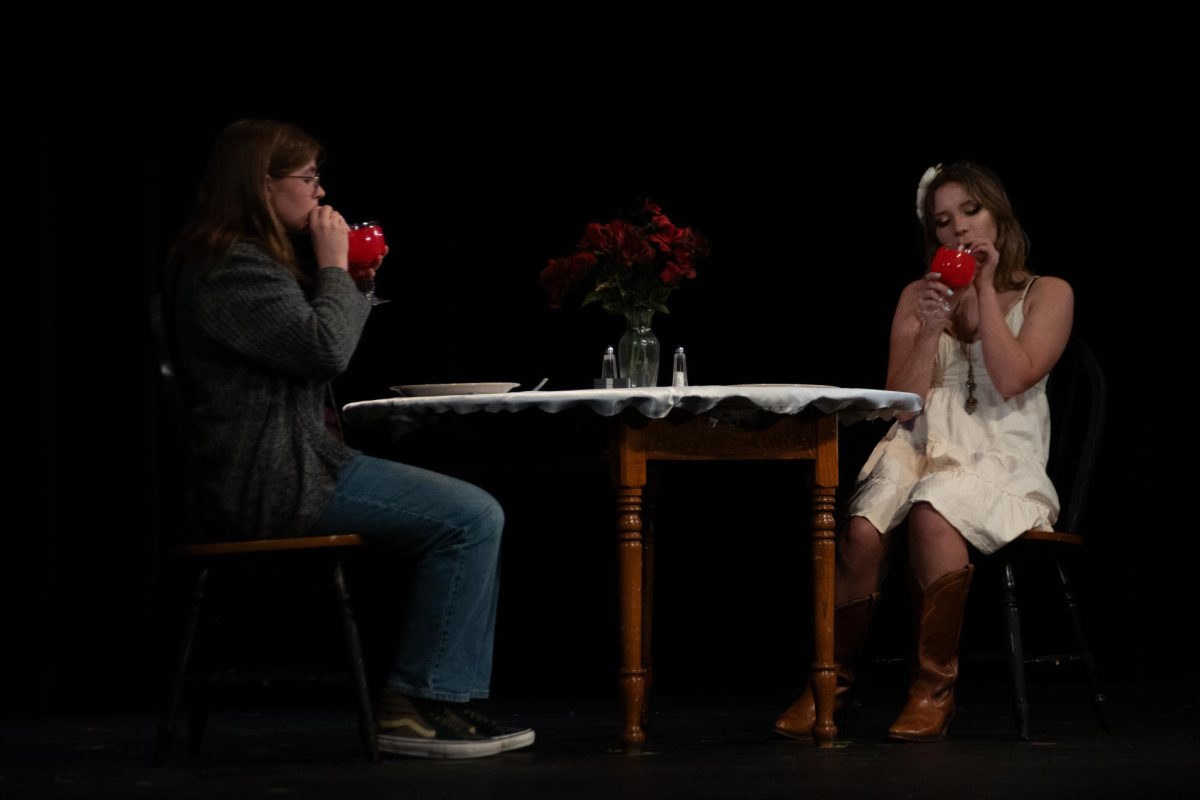A set of six one-act plays, written, directed, performed and mostly produced by students, mixed with student musical interludes, played in the school theater from November 21 to 23 under the patronage of the BHS Drama Program. Talisman editors Abigale Bekele and Xander Howarth both worked in this production.
A Crime to Fuel Insanity (by Sam Ruzumna, directed by Corinne Iacobucci)
This comedic first play depicts a pair of police officers (Adrien Nolte and Amara Shelton) interrogating a hard-to-crack criminal (Gamma Brown). Finn Harrison (Calvin Davidson), an incompetent trainee, pretends he is the captain’s son, coerces them into letting him participate and frustrates them with his bizarre performances, such as mistaking “good cop, bad cop” for “good cop, sad cop” and pleading for a confession. Ultimately, however, he manages to trick the criminal into giving a confession. The other actors’ relatively restrained performances made the trainee’s melodramatics stand out sharply. Finn delivered some great physical comedy, such as pleading on his knees and physically running away at the end when the captain exposes his lie. On the whole. a great show to set the tone for the “One-Acts.”
One Small House (by Kyle Brown, directed by Jojo Foster)
This serious play showed a bittersweet scene in the life of a dysfunctional family whose depressed mother (Sigrid Van Natta) leaves the household responsibility to the oldest child, Alfonso (Killian Patton), and whose younger child (Kyle Brown) loses themselves in video games. The play began with fights between the family members and ended with a reconciliation between the siblings. The angry outbursts tugged at the heartstrings and built up tension for a comforting restoration; as one of the only serious plays, “One Small House” bore its heavy burden well.
Super Duper (by Corinne Iacobucci, directed by Sam Ruzumna)
“Super Duper,” the show with the largest main cast and most intricate plot, showed a meeting of a group of superheroes disguised as a school embroidery club (Ryan de Forest, Skye Cristopher, Ruth Jenkins, Henry Frosch). Unfortunately, these heroes have useless superpowers, such as flying a few meters directly into the air. The show begins with the League of Useless Superpowers admitting a new member (Lilija Goulart). The arrival of a non-superhero trying to join Embroidery Club presents a slight inconvenience. However, when Mrs. Brindlestaff (Nia Clark-Thompson), their kindly, usually absent cat-lady supervisor, attacks the club as the supervillain Duplicity, this new member defeats her and enters the club. Super Duper did a great job of juggling many different characters and giving everyone enough to do. It also had the most advanced props and costuming department, with Duplicity arriving in a colorful supervillain outfit and attacking by hurling large stuffed tigers, which she makes the heroes hallucinate as real.
Bloom (by Phoenix Hagen, directed by Ellie Getman)
Set in Paris, “Bloom” shows a struggling writer (Isabella Ward de Campos Goncalves) who shares his troubles with a woman on the street. She tells him to find inspiration in the people of the city, comparing them to a bouquet of roses that she gives him. The writer trades the flowers to passersby in exchange for their stories, such as how a fashion designer got her dog. As each passerby narrates, a silent play acts out their story in the background. These stories show great invention within their short length, and leave one wanting to know more about their tellers. They’re almost mini-plays within the play. By the end, the writer has an endless supply of people seeking to trade stories for roses. “Bloom” brings a sense of idealism and innocence to the “One-Acts.”
The Perfect Victim (by Oleksandra Prokopenko, directed by Daxson Dee)
In this piece, a serial killer named Alex Archibald runs amok, leaving his name at the scene of each killing. One day, a series of interviewees show up at one Alex Archibald’s office, hoping he’ll select them as his next victim. “The Perfect Victim” uses a few simple, effective comedic tricks: first, it uses a twist on a simple situation that we’re all familiar with. In fact, Prokopenko said that the show’s concept started with wanting to write about a job interview. Second, it treats an absurd scenario seriously. The interviewees each behave like they’re at a normal job interview, listing reasons why he should kill them (they have no friends and nobody would notice their death, they’re very fit and could give a thrilling chase scene) until Archibald drives them out in confused anger. It eventually turns out he’s hiring for an accounting firm, and only happens to share a name with the killer. This play functions as an incisive satire of the true-crime obsession and romanticization of serial killers, giving the show something to say about current events.
A Proposed Haunting (by Xander Howarth, directed by Zirahuen Huerrejon-Crutcher)
This comedy piece deals with an afterlife nobody expected – spending eternity ruining awful people’s proposals. Elsa Selleck played a new ghost while Gianna Golden played the experienced, smug guide to hauntings. Set in a restaurant with Magnolia (Indigo Freeman-Burnett), a snake-oil-hawking influencer, and her arrogant boyfriend Ryder (Ayden Friend), the ghosts ruin Ryder’s proposal with pranks like tapping his shoulder and taking the ring before he presents it. Moira goes from shock (quickly killed by an IKEA bookshelf) to excitement for her afterlife, transformed by “the magic of petty”. This show also amusingly treats current events, Magnolia satirizing selfish influencers and Alexis referring to the ghosts as “dead as democracy.”
The performance also had musical elements. A jazz band played before and after the show, and students (Solenne Dauot, Teddy Dodd, Anna Hoffman, Hailey Hutchins, Corinne Iacobucci, Lucas Malouf, Miriam Mathan, Natalie McManus, Audrey Nordtvelt), performed various song covers between the plays. The songs were a varied bunch, from the rock tune “Come a Little Bit Closer” by Jay and the Americans to the Gershwin brothers’ “Let’s Call the Whole Thing Off”, a 30s movie musical song.
All in all, the One-Acts were quite enjoyable. The production did an excellent job of working at a small scale, observing that “less is more.” For instance, each show dealt with only one scene, with no jumps in space or time, making the show more intimate and allowing the audience to more easily get involved. Similarly, the plays use simple sets, generally using tables and couches to suggest rooms. The lighting, sound design, stage management, and makeup were collectively essentially flawless, showing great skill on the part of the backstage crew. I for one hope the tradition will continue.




















